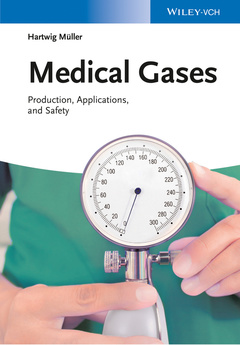Description
Medical Gases
Production, Applications, and Safety
Author: Müller Hartwig
Language: English
Subject for Medical Gases:
184 p. · 17.5x25.2 cm · Hardback
Description
/li>Contents
/li>Biography
/li>
An essential guide for researchers and professionals whose work includes the manufacture, handling, or use of medical gases.
Preface IX
General Remarks XI
1 Medicinal Gases – Manufacturing 1
1.1 Where Do the Gases Come from? 1
1.1.1 Gases Obtained from Air: Oxygen, Nitrogen, Argon, Xenon 1
1.1.1.1 Oxygen 6
1.1.1.2 Nitrogen 8
1.1.1.3 Argon 9
1.1.1.4 Xenon 9
1.1.2 Gases Separated from Other Sources: Helium, Carbon Monoxide, Methane 11
1.1.2.1 Helium 11
1.1.2.2 Carbon Monoxide 15
1.1.2.3 Methane 17
1.1.3 Gases from Chemical Synthesis: Carbon Dioxide, Nitric Oxide, Nitrous Oxide 17
1.1.3.1 Carbon Dioxide 17
1.1.3.2 Nitric Oxide 18
1.1.3.3 Nitrous Oxide 19
1.1.4 Gas Mixtures for Inhalation 20
1.1.4.1 Reconstituted (Synthetic) Air 21
1.1.4.2 Compressed Medical Air 22
1.1.4.3 Nitrous Oxide 50 vol% in Oxygen 22
1.1.4.4 Nitric Oxide Approximately 1000 ppm in Nitrogen 22
1.1.4.5 Mixtures with the General Composition Carbon Monoxide, Helium in Synthetic Air (Carbon Monoxide Ranging between 0.2 and 0.3 vol%, Helium between 8 and 18 vol%) 22
1.1.4.6 Carbogen (5 vol% Carbon Dioxide in Oxygen) 22
1.1.5 Gas Mixtures for Reference – Calibration Gas Mixtures 23
2 Pressure Vessels and Their Accessories 27
2.1 Transportable Pressure Receptacles: Pressure Cylinders 29
2.1.1 Seamless Steel Cylinders 30
2.1.2 Seamless Aluminum Cylinders 31
2.1.2.1 Specifics of Aluminum Cylinders 33
2.1.3 Welded Steel Vessels 34
2.1.4 LightweightWrapped Steel or Aluminum Cylinders 34
2.1.5 Pharmaceutical View on Cylinders as Containment for Drugs 36
2.1.5.1 European Pharmacopoeia View on Cylinders as Containment for Drugs 37
2.1.5.2 Inner and Outer Surfaces of Cylinders 37
2.1.6 Accessories for Cylinders: Valves 39
2.1.6.1 Accessories for Valves: Gaskets 42
2.1.6.2 Valves with Integrated Residual Pressure/Nonreturn Cartridge (NRV/PRV) 43
2.1.6.3 Integrated Valves 44
2.2 Non-transportable Pressure Receptacles: Stationary (Pressure) Tanks for Cryogenic Liquids 46
2.2.1 Safety Measures on Stationary Tanks 47
2.2.2 European Pharmacopoeia View on Cryo-Tanks as Containment for Drugs 48
2.2.3 Inner and Outer Surfaces of Cryo-Tanks 49
2.2.4 Accessories for Cryo-Containers 50
2.2.5 Choice of the Good Location for Tanks 52
2.3 Medicinal Gas Pipeline Systems (MGPS) 53
2.3.1 Elements of a Medical Gas Pipeline System (MGPS) 56
2.3.1.1 Gas Terminal Units (Wall Sockets) 57
2.3.2 Tests and Checks before Going Onstream 60
2.3.3 Operation of a Central Medical Supply System 60
2.3.4 Maintenance and Service, Pharmaceutical View 62
3 AnalyticalMethods for Gases (as Described in Ph. Eur.) 65
3.1 Sampling 65
3.1.1 Permanent Gases 65
3.1.2 Gases Liquefied under Pressure 66
3.1.3 Cryogenic Gases 69
3.2 Gas Analytical Methods 71
3.2.1 Infrared (IR-) Spectrometry 73
3.2.1.1 Calibration 74
3.2.2 Gas Chromatography (Lit) 76
3.2.2.1 Calibration 80
3.2.3 Chemiluminescence 80
3.2.3.1 Calibration 81
3.2.4 Paramagnetic Measurement 82
3.2.4.1 Calibration 82
3.2.5 Moisture Measurement 83
3.2.5.1 Calibration 85
3.2.6 Fluorescence Analysis 85
3.2.6.1 Calibration 86
3.2.7 Test Tubes 86
4 Monographs for Gases in the European and National Pharmacopoeias 91
4.1 European Pharmacopoeia Specifications 91
4.1.1 General Composition of Monographs 91
4.1.2 Use of Monographs in the Industry 93
4.1.3 Other Descriptions from the Ph. Eur. 96
5 Production of Medical Gases—Special Handling to Comply with GMP Rulings 99
5.1 History – Gases Becoming Medicinal Products 99
5.2 Classification of Gases or Gas Mixtures as Medicinal Products 102
5.2.1 Conclusion 105
5.3 Basic Requirements (Volume 4, Part I) ([79] – GMP-Guidelines) 107
5.3.1 Pharmaceutical Quality System (PQS) and ICH Q10 107
5.3.2 Personnel 109
5.3.3 Premises and Equipment 110
5.3.3.1 Annex 6 112
5.3.4 Documentation 112
5.3.5 Production 117
5.3.5.1 Annex 6 118
5.3.6 Quality Control 119
5.3.6.1 Annex 6 121
5.3.7 Outsourced Activities 121
5.3.8 Complaints and Product Recall 122
5.3.9 Self-Inspection 124
5.4 Basic Requirements for Active Substances Used as Starting Materials (Part II of the GMP-Guide) 124
5.4.1 Annex 6 126
5.5 GMP-Related Documents (Part III of the GMP Guide) 126
5.5.1 Site Master File (SMF) 126
5.5.2 ICH-Q9 Quality Risk Management 128
5.5.3 Q10 Note for Guidance: PQS 128
5.5.4 MRA Batch Certificate 128
5.5.5 Written Confirmation 129
6 Requirements of the New Good Distribution Practice (GDP) 131
6.1 Gas in Packages – No Difference from Other Medicinal Products 131
6.1.1 GDP – Targets and Tools 131
6.1.1.1 GDP – Quality Management 132
6.1.1.2 GDP – Personnel 133
6.1.1.3 GDP – Premises and Equipment 133
6.1.1.4 GDP – Documentation 133
6.1.1.5 GDP – Operations 135
6.1.1.6 GDP – Complaints, Returns, Suspected Falsified Medicinal Products, and Medicinal Product Recalls 135
6.1.1.7 GDP – Outsourced Activities 136
6.1.1.8 GDP – Self-Inspections 136
6.1.1.9 GDP – Transportation 136
6.1.1.10 GDP – Specific Provisions for Brokers 136
6.1.1.11 GDP – Conclusions 136
7 Safe Handling of Gases 139
7.1 Safe Handling of Gases 139
7.1.1 Hazards and Risks 139
7.1.2 Safety and the Pressure Container 142
7.1.3 Main Technical Risks 142
7.1.3.1 Storage 142
7.1.3.2 Transport 143
7.1.3.3 Application 144
7.1.4 Pharmaceutical Safety 144
7.2 Safety and Pressure 147
7.3 The Compound’s Chemical Properties 148
7.4 Cryogenic Liquids: Low Temperature and Vast Development of Gas 151
7.5 Gases Tapped from Piping Systems: Cross-Contamination and Contamination by Insufficient Handling, Memory Effects 154
References 157
Abbreviations 163
Index 165
These books may interest you

The CoGDEM Guide to Gas Detection 183.70 €

Handbook of Purified Gases 210.99 €

Handbook of Purified Gases 147.69 €

